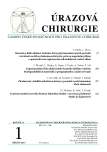Hinged external fixation of the elbow - optimal axis alignment to minimize motion resistence during the movement - cadaveric study
Authors:
Martin Feranec; Radek Hart; Tomáš Kozák
Authors‘ workplace:
Department of orthopaedics and traumatology, Znojmo, Czech Rebublic
; Ortopedicko-traumatologické oddělení nemocnice Znojmo
Published in:
Úraz chir. 21., 2013, č.1
Overview
BACKGROUND:
There is a wide range of complex elbow injuries that require a hinged external fixation. The optimal hinge axis position, in the middle of the circle formed by the trochlea for application of the hinged external fixation of the elbow joint is well known. Its correct position is important for the result.
MATERIALS AND METHODS:
A hinged external fixator (Orthofix) was attached to the lateral side of 20 cadaveric elbows in 12 distinct off-axis positions in each specimen. The aim of the study was to evaluate the influence of the fixator malalignment on the constrained motion of the elbow joint. 40 N force had been applied.
RESULTS:
Aligning the fixator hinge along the optimized axis position resulted in a minimal motion reduction of the elbow joint. Malpositioning the hinge by 4 mm posterior caused in average 14° of motion limitation in flexion and by 7 mm caused 32° of limitation. 4 mm anterior malpositioning caused in average 15° of limitation of ROM and by 7 mm 31° of limitation. Malpositioning 4 mm proximal caused 24° of limitation and by 7 mm 36° of motion limitation. Distal malpositioning by 4 mm caused in average 16° motion limitation and by 7 mm caused 35° of limitation. Malpositioning the hinge 15° in inversion, eversion, intrarotation and extrarotation limited motion of the elbow joint in average of 14°.
CONCLUSION:
An optimal fixator hinge position is determine to minimize the increase in motion limitation due to fixator application.
Key words:
External Elbow Fixator, Optimal Axis of the Elbow, Cadaveric Study.
Sources
1. AN, K.N., MORREY, B.F., CHAO, E.Y.S. The effect of partial removal of proximal ulna on elbow constraint. Clin Orthop. 1986, 209, 270–279.
2. HART, R., JANEČEK, M., KLUSÁKOVÁ, I. et al. Loketní kloub. Ortopedie a traumatologie. 2. vyd. Praha: Maxdorf, 2012. 560 s.
3. HOTCHKISS, R.N., WEILAND, A. Valgus stability of the elbow. J Orthop Res. 1987, 5, 372–377.
4. KAMINENI, S., HIRAHARA, H., NEALE, P. et al. Effectiveness of the lateral unilateral dynamic external after elbow ligament injury. J Bone Joint Surg Am. 2007, 89, 1802–1809.
5. KNOCH VON F., MARSH, J. L., STEYERS, C et al. A new articulated elbow fixation technice for difficult elbow trauma. Iowa Orthop J. 2001, 21, 13–19.
6. LONDON, J.T. Kinematics of the elbow. J Bone Joint Surg Am. 1981, 63, 529–535.
7. MADEY, S. M., BOTTLANG, M., STEYERS, C. M. et al. Hinged external fixation of the elbow: optimal axis alignment to minimize motion resistance. J Orthop Trauma. 2000, 14, 41–47.
8. MORREY, F. B., SANCHEZ-SOTELO, J. The elbow and its disorders. 4. ed. Philadelphia: Saunders, 2008. 1211 s.
9. MORREY, B.F., ASKEW, L.J., CHAO, E.Y.S. A biomechanical study of normal functional elbow motion. J Bone Joint Surg Am. 1981, 63, 872–877.
10. MORREY, B.F. Current concepts in the treatment of fractures of the radial head, the olecranon, and the coronoid. J Bone Joint Surg Am. 1995, 77, 316–327.
11. PENNIG, D., GAUSEPOHL, T., MADER, K. Transarticular fixation with the capacity for motion in fracture disloca-tions of the elbow. Injury. 2000, 31, 35–44.
12. STAVLAS, P., JENSE, S.L., SOJBJERG, J.O. Kinematics of the ligamentous unstable elbow joint after application of a hinged external fixation device: a cadaveric study. J Shoulder Elbow Surg. 2007, 16, 491–496.
13. TAN, V., DALUISKI, A., CAPO, J., et al Hinged elbow external fixators: indications and uses. J Am Acad Orthop Surg. 2005, 13, 503–514.
Labels
Surgery Traumatology Trauma surgeryArticle was published in
Trauma Surgery

2013 Issue 1
Most read in this issue
- Experimental treatment of the diaphyseal bone defect by using tricalcium phosphate
- Evaluation of results of spleen embolization in polytraumatized patients – 4year experience
- Hinged external fixation of the elbow - optimal axis alignment to minimize motion resistence during the movement - cadaveric study
- Intensity and duration of tissue ischemia in severe polytraumatized patients in dependent on duration of prehospital care, care in emergency and operation time registred by microdialysis
